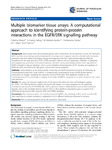Multiple biomarker tissue arrays: a computational approach to identifying protein-protein interactions in the EGFR/ERK signalling pathway

Ver/
Use este enlace para citar
http://hdl.handle.net/2183/19548Coleccións
- Investigación (FCS) [1293]
Metadatos
Mostrar o rexistro completo do ítemTítulo
Multiple biomarker tissue arrays: a computational approach to identifying protein-protein interactions in the EGFR/ERK signalling pathwayAutor(es)
Data
2012-09-01Cita bibliográfica
Medina Villaamil V, Aparicio Gallego G, Valladares-Ayerbes M, Santamarina Caínzos I, Antón Aparicio LM. Multiple biomarker tissue arrays: a computational approach to identifying protein-protein interactions in the EGFR/ERK signalling pathway. J Mol Signal [Internet]. 2012 Sep 1 [acceso 2017 Sep 29];7:14. Disponible en: https://jmolecularsignaling.biomedcentral.com/articles/10.1186/1750-2187-7-14
Resumo
[Abstract]
Background. Many studies have demonstrated genetic and environmental factors that lead to renal cell carcinoma (RCC) and that occur during a protracted period of tumourigenesis. It appears suitable to identify and characterise potential molecular markers that appear during tumourigenesis and that might provide rapid and effective possibilities for the early detection of RCC. EGFR activation induces cell cycle progression, inhibition of apoptosis and angiogenesis, promotion of invasion/metastasis, and other tumour promoting activities. Over-expression of EGFR is thought to play an important role in tumour initiation and progression of RCC because up-regulation of EGFR has been associated with high grade cancers and a worse prognosis.
Methods. Characterisation of the protein profile interacting with EGFR was performed using the following: an immunohistochemical (IHC) study of EGFR, a comprehensive computational study of EGFR protein-protein interactions, an analysis correlating the expression levels of EGFR with other significant markers in the tumourigenicity of RCC, and finally, an analysis of the utility of EGFR for prognosis in a cohort of patients with renal cell carcinoma.
Results. The cases that showed a higher level of this protein fell within the clear cell histological subtype (p = 0.001). The EGFR significance statistic was found with respect to a worse prognosis. In vivo significant correlations were found with PDGFR-β, Flk-1, Hif1-α, proteins related to differentiation (such as DLL3 and DLL4 ligands), and certain metabolic proteins such as Glut5. In silico significant associations gave us a panel of 32 EGFR-interacting proteins (EIP) using the APID and STRING databases.
Conclusions. This work summarises the multifaceted role of EGFR in the pathology of RCC, and it identifies EIPs that could help to provide mechanistic explanations for the different behaviours observed in tumours.
Palabras chave
EGFR
Interacting proteins
Renal cell carcinoma
Tissue array
Interacting proteins
Renal cell carcinoma
Tissue array
Versión do editor
Dereitos
Atribución 3.0 España
ISSN
1750-2187






